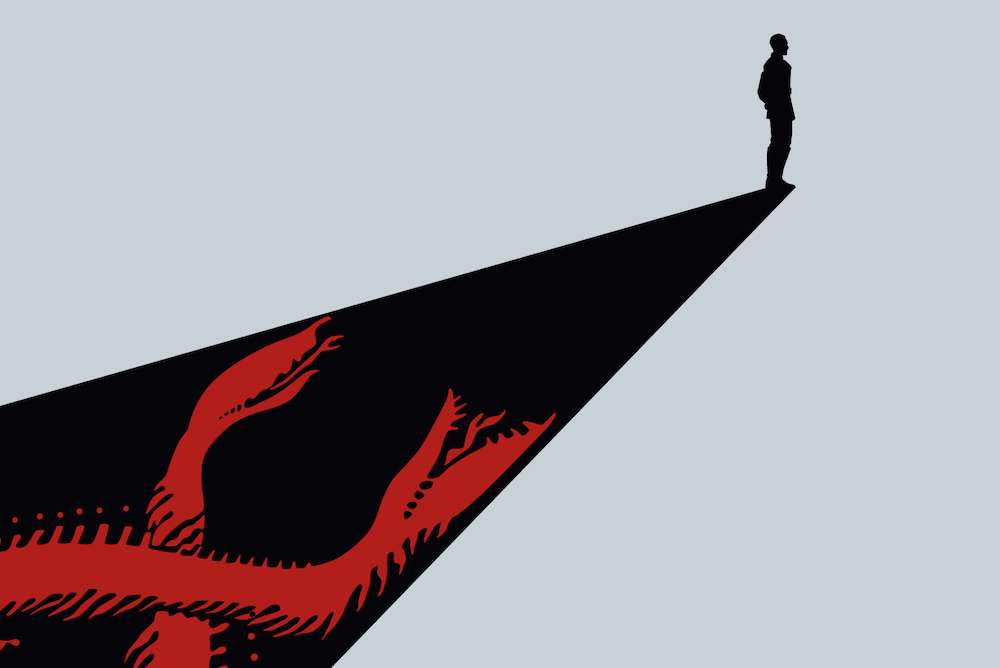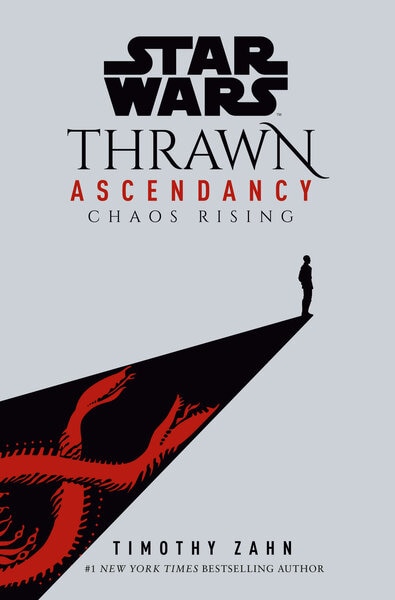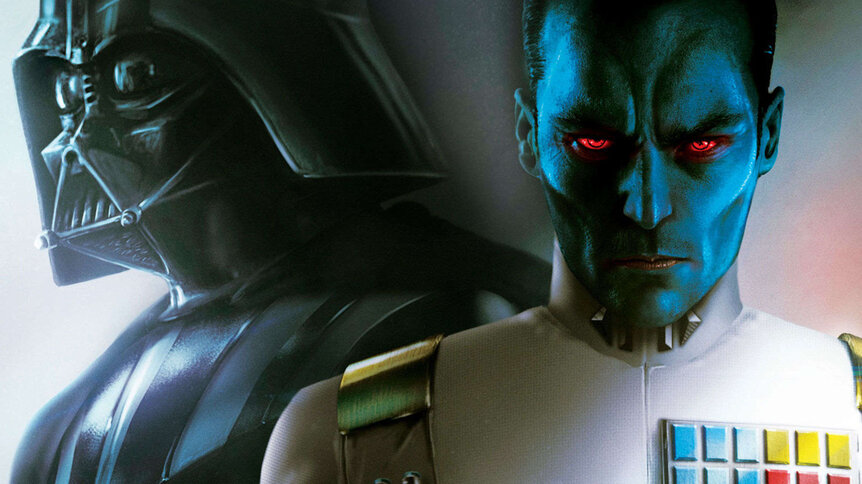Create a free profile to get unlimited access to exclusive videos, sweepstakes, and more!
Author Timothy Zahn explores Thrawn's early Chiss days in new Star Wars book trilogy

New York Times bestselling author Timothy Zahn has made a Star Wars superstar out of Grand Admiral Thrawn, the devious blue-skinned Chiss tactician first introduced in 1991's Heir to the Empire, then expanded in Zahn's most recent Thrawn Trilogy (Thrawn, Thrawn: Alliances, and Thrawn: Treason) and also seen in Disney's animated series, Star Wars Rebels.
Now Zahn is traveling back in time to fill out the intriguing details of Thrawn's early life prior to his meteoric rise within the ranks of the Imperial Navy in the first book of a new Star Wars trilogy, Thrawn Ascendancy: Chaos Rising (out Sept. 1). Here, SYFY WIRE has an exclusive chapter excerpt from the book, and chatted with the novel's award-winning writer to fill us in on what fans might expect.
Prior to climbing to the exalted position of Grand Admiral for the evil Empire during the Clone Wars, Thrawn resided in the Unknown Regions and flourished amid the Nine Ruling Families of the mysterious Chiss Ascendancy. Thrawn thrived as a renegade young military officer of the Ascendancy, which was an intimidating isolationist government run by the Chiss existing outside the normal Star Wars galaxy.
When the Chiss capital is attacked by an unknown enemy from beyond their borders, Thrawn is dispatched to investigate and suspects there's a vast conspiracy brewing. With the power of the Expansionary Fleet and the aid of his comrade Admiral Ar’alani, answers begin to tumble into place.
But as Thrawn’s initial command delves deeper into the vast stretch of open space called the Chaos, he realizes that the mission he's been assigned to is not exactly what it seems.
"With Thrawn: Treason completed, and the post-Star Wars Rebels era still locked down (and with Thrawn himself still popular among the readers), Del Rey and LFL thought that a series of books set in the Chiss Ascendancy and dealing with Thrawn’s earlier life might be worth exploring," Zahn tells SYFY WIRE. "Since I’d never really gotten to explore the Ascendancy and the Chiss culture, and since I’m always open to more Thrawn, I was delighted to get aboard the project."
"We’d seen a lot of Thrawn dealing with Imperials and Rebels, but relatively little of his relationship with his own people," he notes. "Now, we’ll get to dig into those formative years, and to see how Thrawn is viewed by his officers, superiors, and the overall political and military structure. We’ll also explore how he and the Ascendancy relate to other alien species in the area, and some of the threats facing them.
"There’s always been a certain fascination with this non-human who was able to rise to the very height of the Empire’s military, a leader who could out-think his opponents, and who could give even powerful figures like Darth Vader and Luke Skywalker a run for their money. The Chiss themselves had also been portrayed as highly effective warriors, but their origin and society have always been shrouded in mystery."
Check out our exclusive chapter excerpt from Thrawn Ascendancy: Chaos Rising by Timothy Zahn and published by Del Rey Books. Audiobook published by Penguin Random House Audio and is narrated by Marc Thompson.
A key part of Chaos Rising are “memories” – interstitial chapters spread throughout the novel that flashback to critical moments in Thrawn’s life. As a cadet, he more than once found himself under suspicion of cheating or other such allegations of impropriety because of his skills/intellect. After one particular incident where Ar’alani helped Thrawn overcome serious charges, Thrawn invites her out to celebrate as a thank you. For Ar’alani (known then as Ziara, and a member of the rival Irizini family) the evening does not unfold quite as she imagined.
MEMORIES IV –
General Ba’kif had told Ziara that she had good instincts. But she quickly learned that good unfortunately didn’t mean perfect.
The first such lesson came very quickly. The weekend after Thrawn was acquitted he called to invite her out, to help him celebrate and as a thank-you for her help. From the enthusiastic way he talked about the evening, she’d envisioned a night of music and food, perhaps a gymnastic or musical performance, and certainly a modicum of drink.
What she got instead—
She looked around her at the quiet patrons and the somber colors, at the neatly arranged hangings, pictures, sculptures, and drapings. “An art gallery,” she said, her voice flat. “You brought me to an art gallery.”
“Of course,” he said, giving her a puzzled look. “Where did you think we were going?”
“You said there would be insight, drama, and the excitement of discovery,” she reminded him.
“There is.” He pointed down a hallway. “The history of the Ascendancy is in these rooms, some of the pieces dating back to Chiss participation in the wars between the Galactic Republic and the Sith Empire.”
“I seem to remember that era not being a particularly glowing time for the Ascendancy.”
“Agreed,” Thrawn said. “But look at how our tactics and strategies have changed since then.”
Ziara frowned. “Excuse me?”
“Our tactics and strategies,” Thrawn repeated, frowning back.
“Yes, I heard you,” Ziara said. “Why are we talking tactics in an art gallery?”
“Because the one is reflected in the other,” Thrawn said. “Art mirrors the soul, from which tactics arise. One can see in artwork the strengths and weaknesses of those who created it. In fact, if one has a sufficient variety of art to study, one can extend and extrapolate to the strengths, weaknesses, and tactics of entire cultures.”
Abruptly, Ziara realized her mouth was hanging open. “That’s . . . very interesting,” she managed. Maybe, she thought belatedly, she shouldn’t have worked so hard to get him off the hook after all.
“You don’t believe me,” Thrawn said. “Fine. There are alien artworks two chambers over. You pick whichever culture you want, and I’ll show you how to read their tactics.”
Ziara had never been in an alien art wing, in this gallery or any other. The closest she’d ever come to non-Chiss artifacts, in fact, was the twisted chunk of debris from a Paataatus warship that was displayed at the Irizi family homestead on Csilla. “Where did all this come from?” she asked, looking at the various flats and sculptures as Thrawn led the way through the entry arch into the hall.
“Most were purchased by various merchants and traders and subsequently donated to the gallery,” Thrawn told her. “Some are from species we still have contact with, but the majority are from aliens we encountered during the Sith Wars, before the retreat back to our own borders. Here we go.”
He stopped in front of a clear-sided case containing translucent bottles and plates. “Scofti formal tableware, from a governmental regime a hundred years ago,” Thrawn identified them. “What do you see?”
Ziara shrugged. “It’s pretty enough. Especially those internal color swirls.”
“How about durability?” Thrawn asked. “Does it seem sturdy?”
Ziara looked closer. Now that he mentioned it . . . “Unless that material is a lot stronger than it looks, not at all.”
“Exactly,” Thrawn said. “The Scofti change leaders and governments frequently, often under violence or the threat of violence. Since each new leader typically reorganizes the prefecture’s palace, all the way down to the décor and the tableware, the artisans see no point in making anything for them that will last longer than a year. Indeed, since the new master often takes pleasure in publicly destroying the personal items of his or her predecessor, there’s a strong incentive to deliberately make everything fragile.”
“Really.” Ziara eyed him suspiciously. “Is that really true? Or are you just guessing?”
“We’ve been in marginal contact with them for the past twenty years,” Thrawn said, “and our records support that conclusion. But I made that assessment from the gallery’s artifacts before I looked up the history.”
“Mm.” Ziara looked at the items another moment. “Okay. What’s next?”
Thrawn looked around the room. “This is an interesting one,” he said, pointing toward another display case nearby. “They called themselves the Brodihi.”
“Called, past tense?” Ziara asked as they walked over to it. “They’re all dead?”
“We don’t actually know,” Thrawn said. “These artifacts were recovered from the wreckage of a downed ship over three hundred years ago. We still don’t know who they were, where they came from, or whether they still exist.”
Ziara nodded as she did a quick scan of the case’s contents. More dinnerware—plates plus elongated flatware, all decorated with angled rainbow-colored stripes—plus a few tools. In the back of the case was a picture of an alien with a long snout and a pair of horns jutting from the top of its head, along with a short description of the creatures and the circumstances of the discovery. “So what can you tell me about them?”
“You’ll note the angled color bars on the flatware,” Thrawn said. “In order for the lines to match, the knives, forks, and spoons must be angled toward the center of the table and then back toward the edge.”
Ziara nodded. “Like a pair of opening bird wings.”
“Or . . . ?” Thrawn prompted.
Ziara frowned and took another look at the alien picture. “Or like the shape of their horns.”
“That was my conclusion, as well,” Thrawn agreed. “Also note that while the spoons and forks will point toward the center of the table, the knives must be pointed backward, toward the edge for the color bars to line up. What does that tell you?”
Ziara studied the display, trying to visualize one of the creatures sitting where she and Thrawn were standing, waiting for food to be put on his plate. “The knives are much better weapons than the spoons and forks,” she said slowly. “Positioning the points toward you suggests that you have no animosity or designs against the others at the table.”
“Very good,” Thrawn said. “Now add to that the fact that if you turn the knives over, the pattern suggests that they point toward the center like the other flatware instead of toward the table’s edge. What does that suggest?”
Ziara smiled. The structure of their own Chiss culture gave the answer to that one. “That there’s a social or political hierarchy involved,” she said. “Depending on your rank relative to the others at the table, you turn your knife inward or outward.”
“Again, that was my conclusion as well,” Thrawn said. “One final thing. Note the length of the flatware, clearly designed to deposit the food several centimeters down the snout instead of at the front.”
“Seems odd,” Ziara said. “I’d assume most species’ taste receptors would be at the front of the mouth, on the tongue or their equivalent.”
“That does seem to be the general pattern,” Thrawn said. “It makes me think that their outer rim of teeth was their traditional weapon, and the jaws developed so that they could bite into an enemy without tasting his flesh or blood.”
Ziara wrinkled her nose. “That’s disgusting.”
“Agreed,” Thrawn said. “But if we should ever meet them, we would have an idea of their likely tactics. Close-in weaponry like teeth and knives should translate into a preference for close-in combat, with long-distance weaponry considered secondary or even dishonorable.”
“And a rigid hierarchy with an underlying threat of violence would warn us about with whom and where we negotiate,” Ziara said, nodding. “Interesting. Okay. Where to next?”
“You want to see more?” Thrawn asked, frowning a little.
She shrugged. “We’ve come this far. Might as well make an evening of it.”
She quickly came to regret giving him such an open invitation. By the time she called a halt an hour later, her head was spinning with names, images, and tactical inferences. “Okay, this is all very interesting,” she said. “But near as I can see, nearly all of it is very theoretical. Where we have the aliens’ history, you could have looked it up and backfilled your analysis to fit it.”
“I’ve already said I didn’t do that.”
“But you might have come across something when you were younger and forgotten you’d read it,” Ziara pointed out. “That’s happened to me. And where we don’t have any history, we’ll probably never know if you’re right or wrong.”
“I see,” Thrawn said, his voice suddenly subdued. “I’m . . . I thought this would be interesting to you. I’m sorry if I wasted your time.”
“I didn’t say that,” Ziara protested, eyeing him as a sudden idea occurred to her. “But I’m a practical person, and when I hear a new theory I like to give it a test.”
“Shall we ask the Ascendancy to declare war on someone?”
“I was thinking a little smaller,” she said. “Come on.”
She headed toward the exit. “Where are we going?” Thrawn asked as he caught up with her.
“My quarters,” she said. “I do a little wire sculpting in my spare time to relax. You can study it and see how well you can read my personal strategies and tactics.”
Thrawn was silent a couple of steps. “Are you assuming we’ll someday be at war with each other?”
“Yes, and sooner than you think,” Ziara said with a smile. “Because after you finish, we’re going to go downstairs to the dojo and go a couple of rounds.”
“I see,” Thrawn said. “Stick, or unarmed?”





























